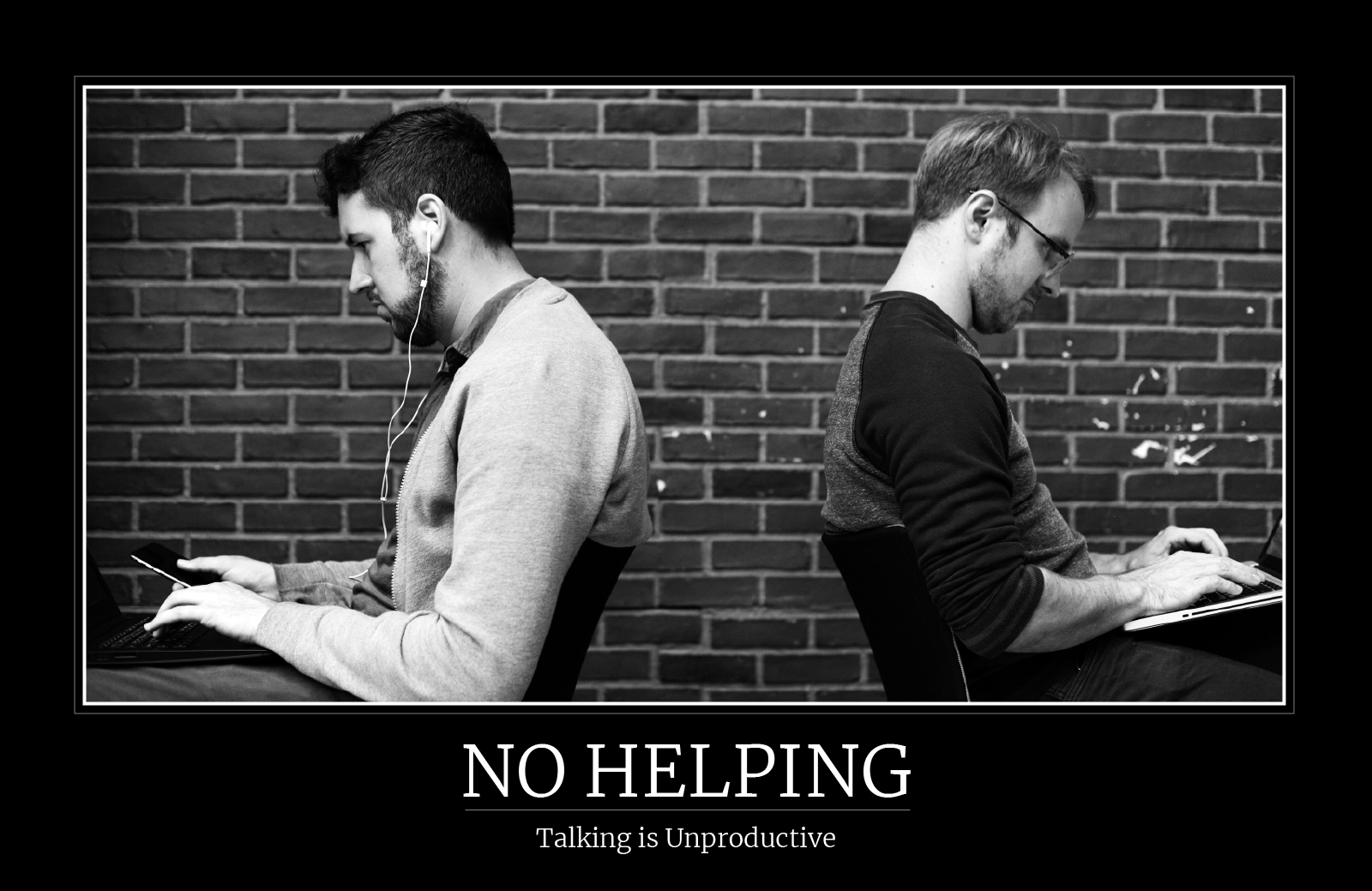A Typical Day at the Office
- 8:43am: Arrive at work.
- 8:47am: Continue working on a prototype for a new feature.
- 9:09am: I’m stuck. I ask a coworker for some quick feedback.
- 9:51am: A tap on the shoulder. It’s a developer with a question on the feature he’s working on. I help him.
- 10:06am: Present my designs to a group of team members. They make some great suggestions.
- 10:45am: Stuck again. This time, it’s a question about Photoshop. I slack another designer. He answers.
- 11:02am: An email from an account manager comes in with a new feature request. I respond.
- 11:11am: My phone buzzes. It’s a slack from our lead tester. I head over to make sure everything’s pixel perfect.
- 11:29am: Ready for a new design challenge, I meet with the product team. We discuss requirements.
- 11:51am: I slack an account manager to set up an interview.
- 12:07pm: Lunch.
If you’re keeping track at home, it’s only noon and I’ve already gotten help or given help to someone a total of 8 times. Joe Cocker’s “I get by with a little help from my friends” song might as well be playing in my headphones all day. And that’s how it should be at a collaborative organization.
Asking for help is something that happens every day. No matter what your role is, there’s always going to be something you need help with; and for people in the business of creating new things, this occurs a lot. We’re constantly searching for answers to questions that have never been asked and we tend to use tools that are ever-evolving and overly complicated (looking at you, Adobe).
On the surface, asking for help seems harmless. But lurking behind the scenes is a dangerous productivity killer. According to experiments conducted by David Meyer, Ph.D., a psychologist at the University of Michigan, “mental blocks created by shifting between tasks can cost as much as 40 percent of someone's productive time.” That’s 16 hours per person per week!
More recently, Gloria Mark of the University of California, Irvine looked at how this concept of task-switching plays out in the workplace and found even more dire news. When an individual is interrupted from their current task, even if only for a brief moment, it adds an additional 25 minutes to the overall time it takes to complete that task. And the scary thing is that those 25 minutes don’t include the time it takes to help out the other person. To make matters worse her research found that “after only 20 minutes of interrupted performance people reported significantly higher stress, frustration, workload, effort, and pressure.”
Now, you might think that the more unrelated the interruption is, the more time the task switching will take. Nope. Gloria and her team found that whether the interruption was related to the current task or not had no difference in the amount of time lost. This means even asking for help from someone working on something related will still cost them 25 minutes.
So the more interruptions in your organization the less productive and more stressed everyone becomes. Seems like a no-brainer to just stop interruptions, right? Unfortunately, we’ve got our own human nature to contend with. Humans have evolved over thousands of years to help out our fellow tribe. Do we really expect our organizations to have a policy where you aren’t allowed to give or ask for help??

Unfortunately, interruptions are more prevalent today than ever before. In addition to the old fashion way of getting up from our desks and actually asking for help in person, we can send someone an email, a text, a slack, or even blast a whole bunch of people at once through any of those channels.
This puts us in a pickle. If we know we’re going to need help throughout our creative endeavors, how in the heck do we actually get it without causing our team to be less productive and more stressed out?
The first step is awareness. Everyone in our organizations needs to understand just how dangerous a quick question from a co-worker can be. Once we accept that constantly interrupting others hurts the team’s productivity we can operate within a set of principles for determining how to get help.
Principle #1: Get your priorities in order.
There are going to be times when the task at hand is both urgent and important. And in these cases asking for help as soon as you get stuck makes sense. But chances are what you need help with doesn’t immediately need to get answered. The problem is that as soon as we get stuck we have a natural urge to want help regardless of how important the task is. This is why understanding priorities is crucial. If we’re stuck on a task that isn’t both urgent and important we should ask ourselves what else can we do to help move the overall project forward. If there’s something of similar importance to what we’re stuck on then we should start working on that while we wait for someone else to be free to help us.
Principle #2: Google first, ask questions later.
There’s a reason why Google is valued at $132.1 Billion and why ‘google’ is officially a word in the dictionary: it’s really helpful. Chances are the answers to our questions can be found online. Yes, it might take a little bit of searching around and yes, we’ve all watched some horrible instructional YouTube Videos before, but in the end, googling delivers results. And oftentimes these results are better than anyone in our office could provide; there are a lot of people with a lot of expertise online. With that being said, there are definitely situations where getting help internally is the only option. For example, if you need help with an internal process or you need feedback on your design, googling for an answer won’t really help. In these cases, it’s totally fine to ask for help. The point is that if we can google for an answer in under 25 minutes, that we’ll have actually saved the organization time.
Principle #3: Timing is everything.
So you’ve determined you need to ask for help, either because it’s something Google can’t answer or you’ve tried for a while and couldn’t find what you needed, now what? This is where timing is key. The main reason interruptions cost us 25 minutes is because when someone is interrupted they are no longer in a state of “flow.” Mihaly Csikszentmihalyi, an expert on creativity, preaches about the importance of being in the zone and how we’re far more productive all of our mental power is devoted to just that task. But as soon as we’re interrupted, it’s over. So in order to reduce the chance of interrupting someone from their flow state the timing of when we ask for help is crucial. If they’re just getting back from lunch, or out of another meeting we know that they’re not in a state of flow. These are the perfect times for asking for help.
Principle #4: Ask in person.
As much as I love technology, I’m a huge advocate for the using the old-fashioned method of getting up from your desk and asking for help. It’s tough to know whether a person is stressed or hard at work on another task without seeing them with our own two eyes. When we force ourselves to get up and ask for help we’re able to pick up on hidden emotional cues that are undetectable online. Knowing whether your coworker is stressed or busy is helpful for figuring out if you should even ask them for help or move on to get help from someone else. One additional benefit to this method is that it acts as a double confirmation. The added effort it takes to stand up and walk over to someone else’s desk forces us to question whether we really need the help right now or whether it could wait.
A Cautionary Tale
During the process of writing this article, I found myself back in my typical work routine. I was stuck and in need of help. So what did I do? Well, I completely forgot everything I just talked about and immediately asked for help.
Admittedly, this is tough. Those natural urges to get help as soon as we’re stuck are fierce. But the stakes are high. The dangers of interrupting our teammates is even more fierce. 16 hours lost per person per week is a whole lot of time. Not to mention all of the added stress.
Ashamed and feeling like a hypocrite, I put together a decision tree to help me determine how and when I should ask for help. It’s based on the four principles of understanding your priorities, googling when you can, interrupting at the right time, and making sure we get up to ask for help in person.

I’m hopeful this decision tree will my teammates and I be more productive, and I'm hopeful it will help you as well. Our organizations should be amazing places full of laughter and collaboration. So the takeaway from this article, shouldn’t be ‘everyone shut up and work’. It should be that we need to mindful when asking for help. We should see if we can solve the problem first and then find the right time to ask our colleagues for help.





